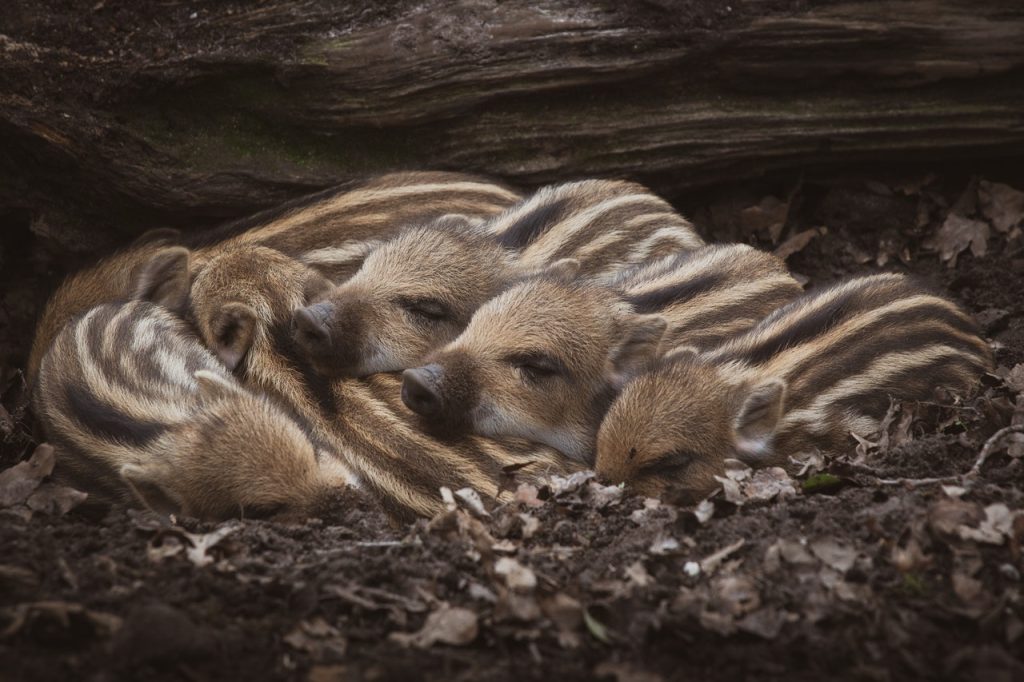
Here’s an article presenting different animals’ sleep patterns.
How Mammals Sleep
Sleep is required to save energy and restore mental and physical strength. Sleep requirements vary depending on various factors, including age, body size, environment, diet, and the security of its sleep location. How a mammal lives can also impact how much sleep it requires.
Like humans, mammals that have been examined exhibit signs of REM sleep (so-called deep sleep), which means that mammals dream.
Animals’ sleep can be categorized either as monophasic or polyphasic. Monophasic sleep characterizes animals who generally sleep for one long period. For example, human sleep is monophasic. This is because the human circadian rhythms make us sleep for more extended periods at night and be more active during the day.
Polyphasic sleep is sleeping in multiple periods throughout the day. Polyphasic sleep is more common in animals, as they often need to maintain vigilance against predators. When the threat is minimized, animals enjoy monophasic sleep. For example, marmosets, who usually sleep in trees surrounded by their family, can feel more protected and experience monophasic sleep.
Examples of mammals and their sleep patterns
Giraffes
Giraffes sleep only as much as a few hours a day. Giraffes sleep for the most part during the night, and they take brief naps throughout the day. Giraffes can fall asleep standing up and resting down, and their sleep cycles are pretty short; they last only 35 minutes or less.
Elephants
Elephants also sleep very little. They can sleep as much as two hours a day, but they can also not sleep for the entire two days when traveling. So instead, elephants can sleep standing up and lying down. You can tell elephants are sleeping when their trunks don’t move.
Bears
Some animals hibernate to conserve energy during season change or when there’s not enough natural food. When hibernating, animals have a lowered metabolism, heart rate, body temperature, and respiratory rate. For example, a bear’s body temperature remains nearly constant while hibernating, although it will not eat or drink for up to seven months.

How Birds Sleep
If you have ever wondered if birds can sleep while flying, we have an answer for you. Some birds can sleep during flying or swimming. It’s possible because of unihemispheric sleep, which means sleeping with one-half of their brain still active.
Due to unihemispheric sleep, birds can protect themselves from predators or migrate over long distances.
For example, sleep in a row. At the end of the line, the ducks will most likely fall asleep unihemispherically, with their outward eye remaining open, while those in the middle sleep hemispherically.
Frigate birds may spend months over the sea and sleep for hours at a time during soaring or gliding flight, with their brains half-engaged. Their wings flap once every few seconds, capturing the rising air currents as they arise. This prevents them from plummeting into the sea for 10-second spurts of continuous sleep. Instead, they get about 12 hours on land, split into one-minute slots.
Fur seals sleep on land with one side of the brain, but when they’re swimming, they return to bihemispheric sleep and sleep with both sides of the brain, like humans.
How Reptiles and Amphibians Sleep
Reptiles’ and amphibians’ sleep hasn’t been studied much. However, we know that reptiles also experience REM sleep in sleep cycles even as short as 80 seconds because of emerging research.
Lizards may sleep on leaves to protect themselves from predators, with their heads oriented towards the path a predator would use to approach them. Crocodiles sleep unihemispherically to keep an eye out for threats and food.
On the other hand, snakes sleep with both their eyes open. They can even sleep for many days to digest their food. Snakes can also rest in a state similar to hibernation, called brumation. It is a state of reduced activity and metabolism in reptiles when colder temperatures occur, and less food is available. For example, salamanders can enter brumation for even 100 days at a time.
This state of inactivity for amphibians is known as estivation. For example, green-striped burrowing frogs enter a state of suspended animation during estivation, burying themselves deep underground, halting all activity and feeding for months.

Conclusion
The article discusses different animal sleep patterns and how they evolved. Each animal’s sleep pattern is suited for their needs and allows them to conserve energy in different ways. For example, some animals, like giraffes, only sleep a few hours a day, while others, like bears, hibernate during certain times of the year. Birds can also sleep while flying or swimming due to unihemispheric sleep. Reptiles and amphibians also experience REM sleep and can enter a state of hibernation or estivation, depending on their needs.
